MGT 251 Planning and Control Quiz: Questions and Answers
VerifiedAdded on 2020/03/04
|5
|1801
|127
Quiz and Exam
AI Summary
This document presents a quiz consisting of 50 multiple-choice questions designed to assess understanding of planning and control principles in project management, as covered in MGT 251. The quiz explores a variety of topics, including the Critical Chain method, Work Breakdown Structures (WBS), earned value management, cost estimation techniques, schedule and cost performance indices, the Theory of Constraints (TOC), risk assessment methodologies, and time-boxed scheduling. Questions address resource allocation, task dependencies, project buffers, and the use of tools like Gantt charts and S-curves for project tracking. Additionally, the quiz includes questions on topics such as multitasking, buffers, and the use of Monte Carlo simulations. This quiz serves as a valuable tool for students to test and reinforce their knowledge of project management concepts.
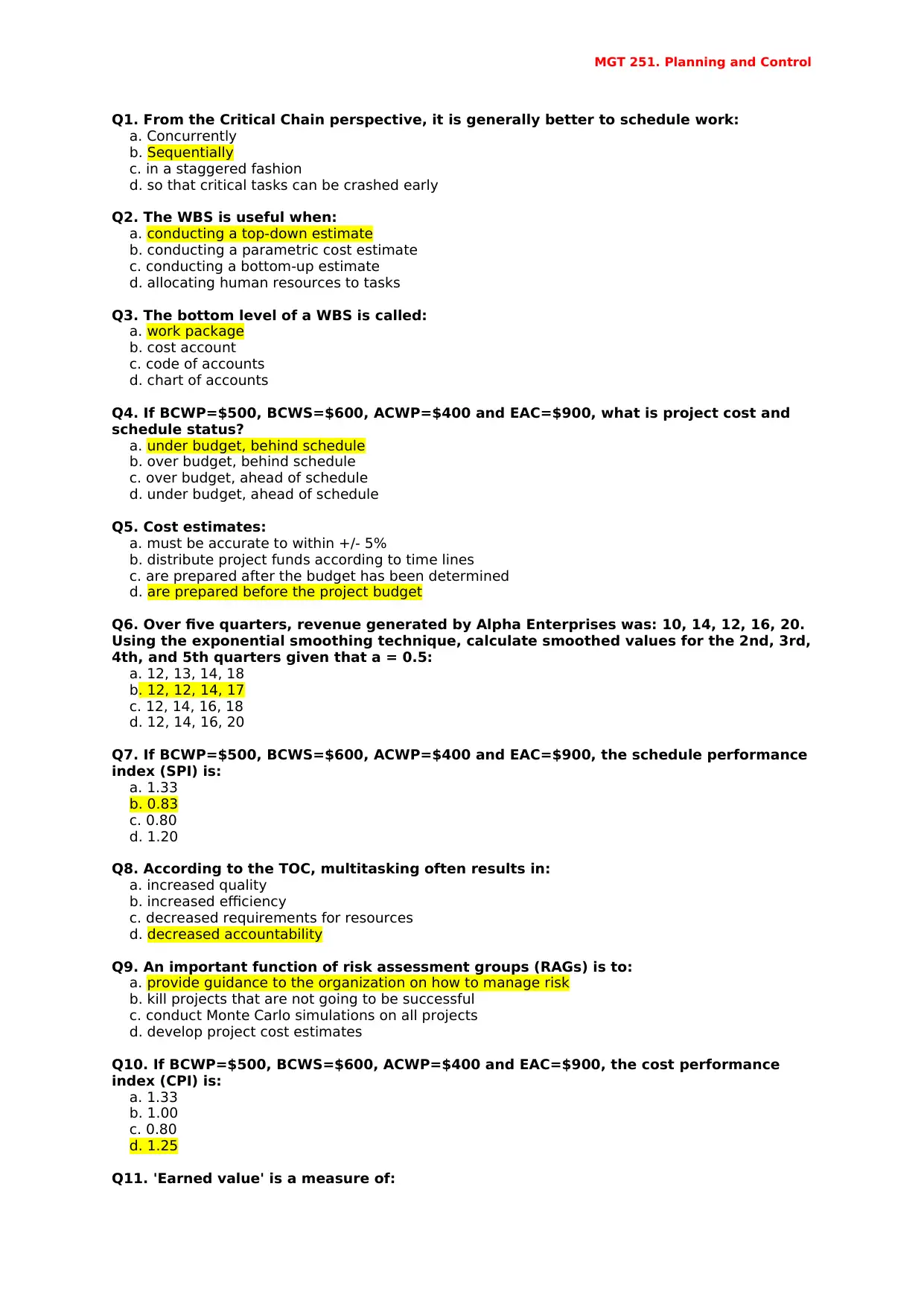
MGT 251. Planning and Control
Q1. From the Critical Chain perspective, it is generally better to schedule work:
a. Concurrently
b. Sequentially
c. in a staggered fashion
d. so that critical tasks can be crashed early
Q2. The WBS is useful when:
a. conducting a top-down estimate
b. conducting a parametric cost estimate
c. conducting a bottom-up estimate
d. allocating human resources to tasks
Q3. The bottom level of a WBS is called:
a. work package
b. cost account
c. code of accounts
d. chart of accounts
Q4. If BCWP=$500, BCWS=$600, ACWP=$400 and EAC=$900, what is project cost and
schedule status?
a. under budget, behind schedule
b. over budget, behind schedule
c. over budget, ahead of schedule
d. under budget, ahead of schedule
Q5. Cost estimates:
a. must be accurate to within +/- 5%
b. distribute project funds according to time lines
c. are prepared after the budget has been determined
d. are prepared before the project budget
Q6. Over five quarters, revenue generated by Alpha Enterprises was: 10, 14, 12, 16, 20.
Using the exponential smoothing technique, calculate smoothed values for the 2nd, 3rd,
4th, and 5th quarters given that a = 0.5:
a. 12, 13, 14, 18
b. 12, 12, 14, 17
c. 12, 14, 16, 18
d. 12, 14, 16, 20
Q7. If BCWP=$500, BCWS=$600, ACWP=$400 and EAC=$900, the schedule performance
index (SPI) is:
a. 1.33
b. 0.83
c. 0.80
d. 1.20
Q8. According to the TOC, multitasking often results in:
a. increased quality
b. increased efficiency
c. decreased requirements for resources
d. decreased accountability
Q9. An important function of risk assessment groups (RAGs) is to:
a. provide guidance to the organization on how to manage risk
b. kill projects that are not going to be successful
c. conduct Monte Carlo simulations on all projects
d. develop project cost estimates
Q10. If BCWP=$500, BCWS=$600, ACWP=$400 and EAC=$900, the cost performance
index (CPI) is:
a. 1.33
b. 1.00
c. 0.80
d. 1.25
Q11. 'Earned value' is a measure of:
Q1. From the Critical Chain perspective, it is generally better to schedule work:
a. Concurrently
b. Sequentially
c. in a staggered fashion
d. so that critical tasks can be crashed early
Q2. The WBS is useful when:
a. conducting a top-down estimate
b. conducting a parametric cost estimate
c. conducting a bottom-up estimate
d. allocating human resources to tasks
Q3. The bottom level of a WBS is called:
a. work package
b. cost account
c. code of accounts
d. chart of accounts
Q4. If BCWP=$500, BCWS=$600, ACWP=$400 and EAC=$900, what is project cost and
schedule status?
a. under budget, behind schedule
b. over budget, behind schedule
c. over budget, ahead of schedule
d. under budget, ahead of schedule
Q5. Cost estimates:
a. must be accurate to within +/- 5%
b. distribute project funds according to time lines
c. are prepared after the budget has been determined
d. are prepared before the project budget
Q6. Over five quarters, revenue generated by Alpha Enterprises was: 10, 14, 12, 16, 20.
Using the exponential smoothing technique, calculate smoothed values for the 2nd, 3rd,
4th, and 5th quarters given that a = 0.5:
a. 12, 13, 14, 18
b. 12, 12, 14, 17
c. 12, 14, 16, 18
d. 12, 14, 16, 20
Q7. If BCWP=$500, BCWS=$600, ACWP=$400 and EAC=$900, the schedule performance
index (SPI) is:
a. 1.33
b. 0.83
c. 0.80
d. 1.20
Q8. According to the TOC, multitasking often results in:
a. increased quality
b. increased efficiency
c. decreased requirements for resources
d. decreased accountability
Q9. An important function of risk assessment groups (RAGs) is to:
a. provide guidance to the organization on how to manage risk
b. kill projects that are not going to be successful
c. conduct Monte Carlo simulations on all projects
d. develop project cost estimates
Q10. If BCWP=$500, BCWS=$600, ACWP=$400 and EAC=$900, the cost performance
index (CPI) is:
a. 1.33
b. 1.00
c. 0.80
d. 1.25
Q11. 'Earned value' is a measure of:
Paraphrase This Document
Need a fresh take? Get an instant paraphrase of this document with our AI Paraphraser
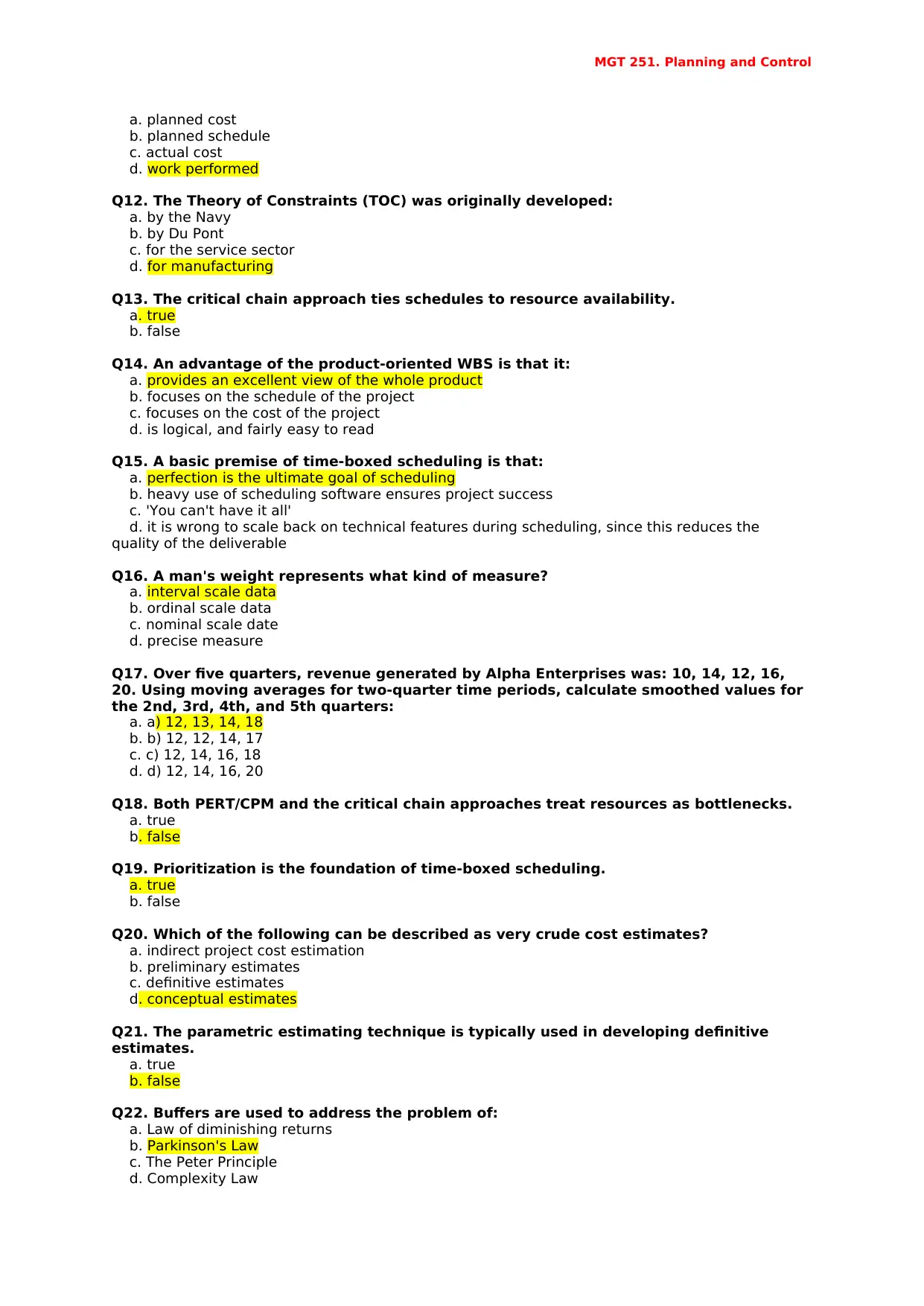
MGT 251. Planning and Control
a. planned cost
b. planned schedule
c. actual cost
d. work performed
Q12. The Theory of Constraints (TOC) was originally developed:
a. by the Navy
b. by Du Pont
c. for the service sector
d. for manufacturing
Q13. The critical chain approach ties schedules to resource availability.
a. true
b. false
Q14. An advantage of the product-oriented WBS is that it:
a. provides an excellent view of the whole product
b. focuses on the schedule of the project
c. focuses on the cost of the project
d. is logical, and fairly easy to read
Q15. A basic premise of time-boxed scheduling is that:
a. perfection is the ultimate goal of scheduling
b. heavy use of scheduling software ensures project success
c. 'You can't have it all'
d. it is wrong to scale back on technical features during scheduling, since this reduces the
quality of the deliverable
Q16. A man's weight represents what kind of measure?
a. interval scale data
b. ordinal scale data
c. nominal scale date
d. precise measure
Q17. Over five quarters, revenue generated by Alpha Enterprises was: 10, 14, 12, 16,
20. Using moving averages for two-quarter time periods, calculate smoothed values for
the 2nd, 3rd, 4th, and 5th quarters:
a. a) 12, 13, 14, 18
b. b) 12, 12, 14, 17
c. c) 12, 14, 16, 18
d. d) 12, 14, 16, 20
Q18. Both PERT/CPM and the critical chain approaches treat resources as bottlenecks.
a. true
b. false
Q19. Prioritization is the foundation of time-boxed scheduling.
a. true
b. false
Q20. Which of the following can be described as very crude cost estimates?
a. indirect project cost estimation
b. preliminary estimates
c. definitive estimates
d. conceptual estimates
Q21. The parametric estimating technique is typically used in developing definitive
estimates.
a. true
b. false
Q22. Buffers are used to address the problem of:
a. Law of diminishing returns
b. Parkinson's Law
c. The Peter Principle
d. Complexity Law
a. planned cost
b. planned schedule
c. actual cost
d. work performed
Q12. The Theory of Constraints (TOC) was originally developed:
a. by the Navy
b. by Du Pont
c. for the service sector
d. for manufacturing
Q13. The critical chain approach ties schedules to resource availability.
a. true
b. false
Q14. An advantage of the product-oriented WBS is that it:
a. provides an excellent view of the whole product
b. focuses on the schedule of the project
c. focuses on the cost of the project
d. is logical, and fairly easy to read
Q15. A basic premise of time-boxed scheduling is that:
a. perfection is the ultimate goal of scheduling
b. heavy use of scheduling software ensures project success
c. 'You can't have it all'
d. it is wrong to scale back on technical features during scheduling, since this reduces the
quality of the deliverable
Q16. A man's weight represents what kind of measure?
a. interval scale data
b. ordinal scale data
c. nominal scale date
d. precise measure
Q17. Over five quarters, revenue generated by Alpha Enterprises was: 10, 14, 12, 16,
20. Using moving averages for two-quarter time periods, calculate smoothed values for
the 2nd, 3rd, 4th, and 5th quarters:
a. a) 12, 13, 14, 18
b. b) 12, 12, 14, 17
c. c) 12, 14, 16, 18
d. d) 12, 14, 16, 20
Q18. Both PERT/CPM and the critical chain approaches treat resources as bottlenecks.
a. true
b. false
Q19. Prioritization is the foundation of time-boxed scheduling.
a. true
b. false
Q20. Which of the following can be described as very crude cost estimates?
a. indirect project cost estimation
b. preliminary estimates
c. definitive estimates
d. conceptual estimates
Q21. The parametric estimating technique is typically used in developing definitive
estimates.
a. true
b. false
Q22. Buffers are used to address the problem of:
a. Law of diminishing returns
b. Parkinson's Law
c. The Peter Principle
d. Complexity Law
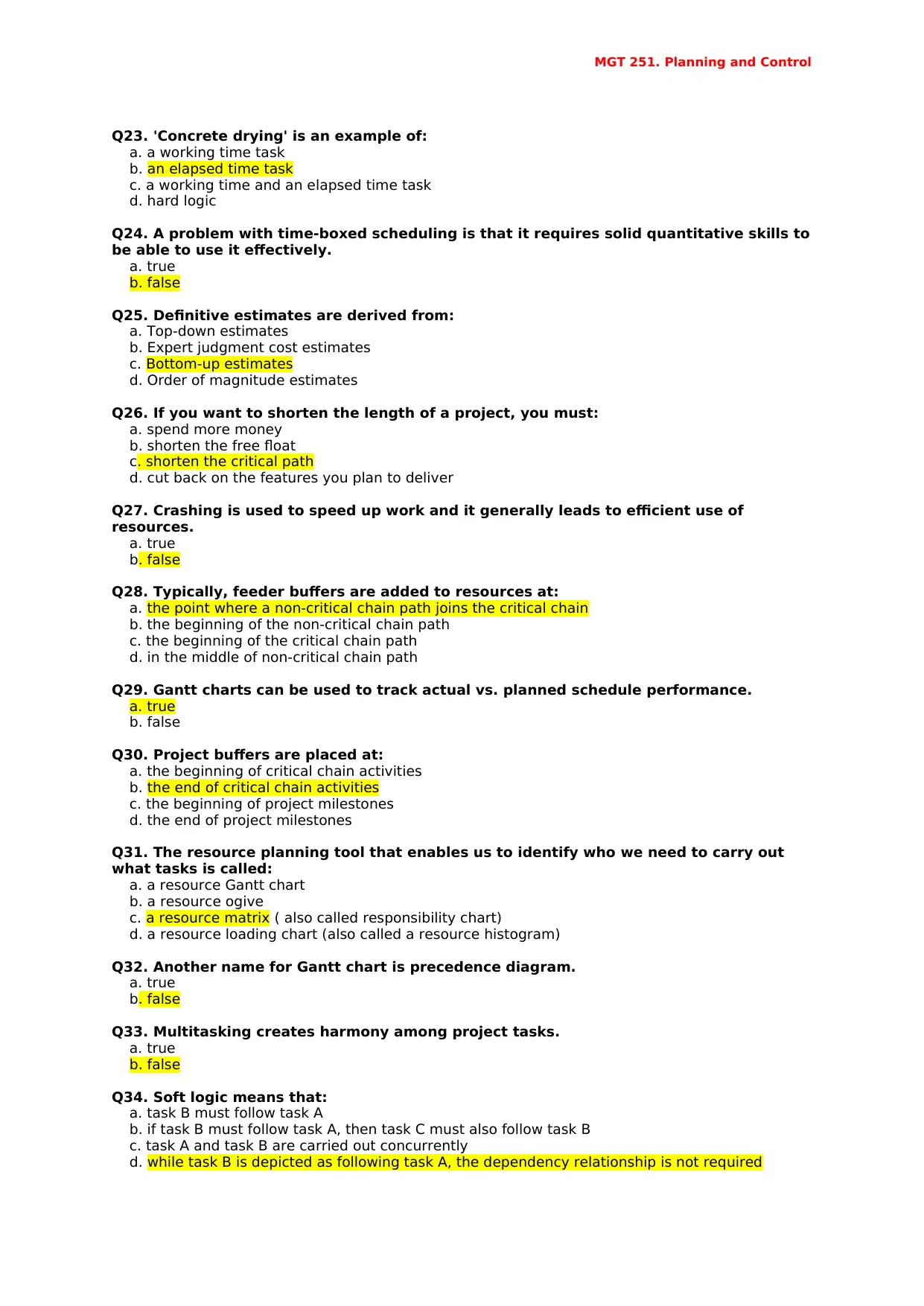
MGT 251. Planning and Control
Q23. 'Concrete drying' is an example of:
a. a working time task
b. an elapsed time task
c. a working time and an elapsed time task
d. hard logic
Q24. A problem with time-boxed scheduling is that it requires solid quantitative skills to
be able to use it effectively.
a. true
b. false
Q25. Definitive estimates are derived from:
a. Top-down estimates
b. Expert judgment cost estimates
c. Bottom-up estimates
d. Order of magnitude estimates
Q26. If you want to shorten the length of a project, you must:
a. spend more money
b. shorten the free float
c. shorten the critical path
d. cut back on the features you plan to deliver
Q27. Crashing is used to speed up work and it generally leads to efficient use of
resources.
a. true
b. false
Q28. Typically, feeder buffers are added to resources at:
a. the point where a non-critical chain path joins the critical chain
b. the beginning of the non-critical chain path
c. the beginning of the critical chain path
d. in the middle of non-critical chain path
Q29. Gantt charts can be used to track actual vs. planned schedule performance.
a. true
b. false
Q30. Project buffers are placed at:
a. the beginning of critical chain activities
b. the end of critical chain activities
c. the beginning of project milestones
d. the end of project milestones
Q31. The resource planning tool that enables us to identify who we need to carry out
what tasks is called:
a. a resource Gantt chart
b. a resource ogive
c. a resource matrix ( also called responsibility chart)
d. a resource loading chart (also called a resource histogram)
Q32. Another name for Gantt chart is precedence diagram.
a. true
b. false
Q33. Multitasking creates harmony among project tasks.
a. true
b. false
Q34. Soft logic means that:
a. task B must follow task A
b. if task B must follow task A, then task C must also follow task B
c. task A and task B are carried out concurrently
d. while task B is depicted as following task A, the dependency relationship is not required
Q23. 'Concrete drying' is an example of:
a. a working time task
b. an elapsed time task
c. a working time and an elapsed time task
d. hard logic
Q24. A problem with time-boxed scheduling is that it requires solid quantitative skills to
be able to use it effectively.
a. true
b. false
Q25. Definitive estimates are derived from:
a. Top-down estimates
b. Expert judgment cost estimates
c. Bottom-up estimates
d. Order of magnitude estimates
Q26. If you want to shorten the length of a project, you must:
a. spend more money
b. shorten the free float
c. shorten the critical path
d. cut back on the features you plan to deliver
Q27. Crashing is used to speed up work and it generally leads to efficient use of
resources.
a. true
b. false
Q28. Typically, feeder buffers are added to resources at:
a. the point where a non-critical chain path joins the critical chain
b. the beginning of the non-critical chain path
c. the beginning of the critical chain path
d. in the middle of non-critical chain path
Q29. Gantt charts can be used to track actual vs. planned schedule performance.
a. true
b. false
Q30. Project buffers are placed at:
a. the beginning of critical chain activities
b. the end of critical chain activities
c. the beginning of project milestones
d. the end of project milestones
Q31. The resource planning tool that enables us to identify who we need to carry out
what tasks is called:
a. a resource Gantt chart
b. a resource ogive
c. a resource matrix ( also called responsibility chart)
d. a resource loading chart (also called a resource histogram)
Q32. Another name for Gantt chart is precedence diagram.
a. true
b. false
Q33. Multitasking creates harmony among project tasks.
a. true
b. false
Q34. Soft logic means that:
a. task B must follow task A
b. if task B must follow task A, then task C must also follow task B
c. task A and task B are carried out concurrently
d. while task B is depicted as following task A, the dependency relationship is not required
⊘ This is a preview!⊘
Do you want full access?
Subscribe today to unlock all pages.

Trusted by 1+ million students worldwide
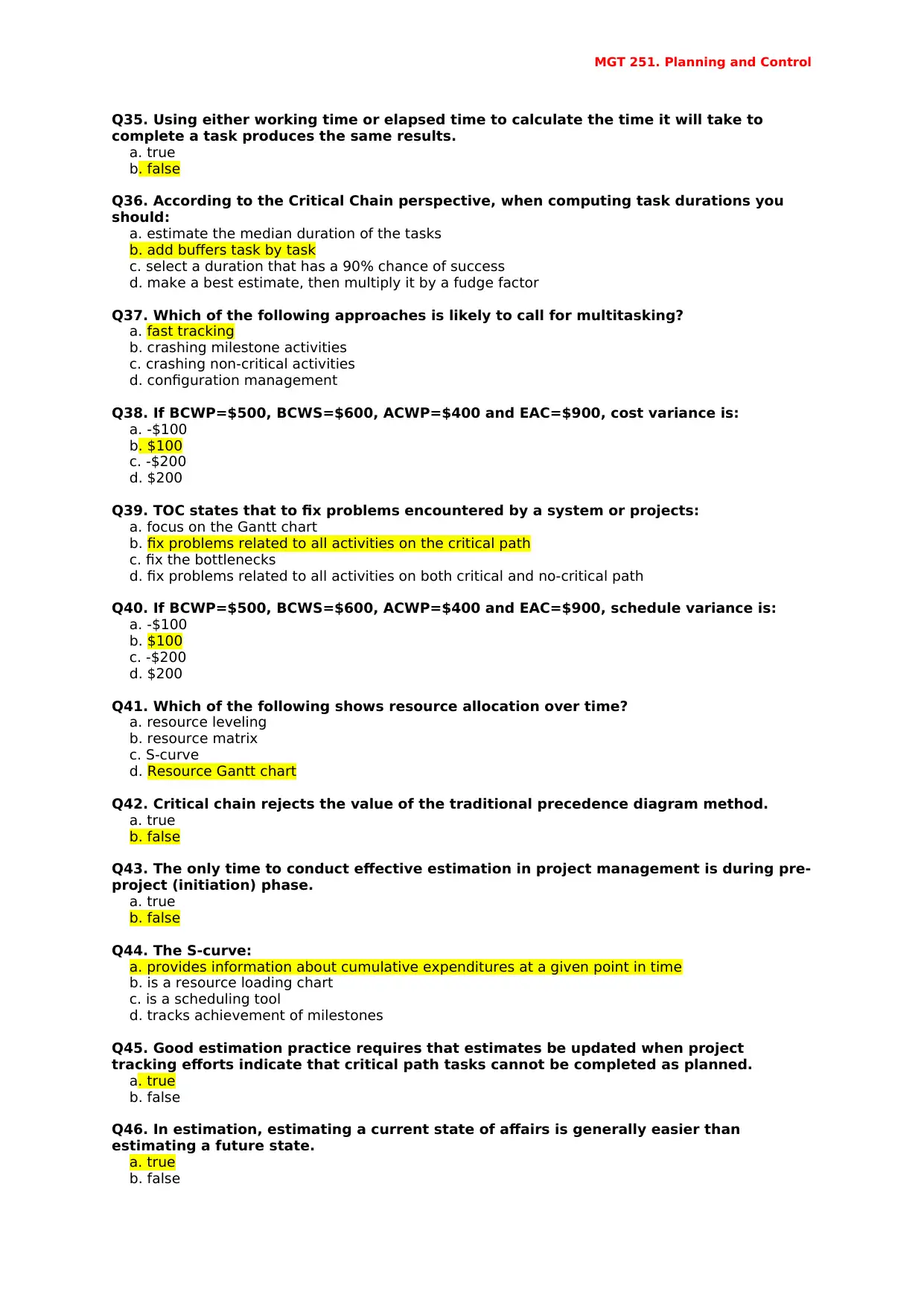
MGT 251. Planning and Control
Q35. Using either working time or elapsed time to calculate the time it will take to
complete a task produces the same results.
a. true
b. false
Q36. According to the Critical Chain perspective, when computing task durations you
should:
a. estimate the median duration of the tasks
b. add buffers task by task
c. select a duration that has a 90% chance of success
d. make a best estimate, then multiply it by a fudge factor
Q37. Which of the following approaches is likely to call for multitasking?
a. fast tracking
b. crashing milestone activities
c. crashing non-critical activities
d. configuration management
Q38. If BCWP=$500, BCWS=$600, ACWP=$400 and EAC=$900, cost variance is:
a. -$100
b. $100
c. -$200
d. $200
Q39. TOC states that to fix problems encountered by a system or projects:
a. focus on the Gantt chart
b. fix problems related to all activities on the critical path
c. fix the bottlenecks
d. fix problems related to all activities on both critical and no-critical path
Q40. If BCWP=$500, BCWS=$600, ACWP=$400 and EAC=$900, schedule variance is:
a. -$100
b. $100
c. -$200
d. $200
Q41. Which of the following shows resource allocation over time?
a. resource leveling
b. resource matrix
c. S-curve
d. Resource Gantt chart
Q42. Critical chain rejects the value of the traditional precedence diagram method.
a. true
b. false
Q43. The only time to conduct effective estimation in project management is during pre-
project (initiation) phase.
a. true
b. false
Q44. The S-curve:
a. provides information about cumulative expenditures at a given point in time
b. is a resource loading chart
c. is a scheduling tool
d. tracks achievement of milestones
Q45. Good estimation practice requires that estimates be updated when project
tracking efforts indicate that critical path tasks cannot be completed as planned.
a. true
b. false
Q46. In estimation, estimating a current state of affairs is generally easier than
estimating a future state.
a. true
b. false
Q35. Using either working time or elapsed time to calculate the time it will take to
complete a task produces the same results.
a. true
b. false
Q36. According to the Critical Chain perspective, when computing task durations you
should:
a. estimate the median duration of the tasks
b. add buffers task by task
c. select a duration that has a 90% chance of success
d. make a best estimate, then multiply it by a fudge factor
Q37. Which of the following approaches is likely to call for multitasking?
a. fast tracking
b. crashing milestone activities
c. crashing non-critical activities
d. configuration management
Q38. If BCWP=$500, BCWS=$600, ACWP=$400 and EAC=$900, cost variance is:
a. -$100
b. $100
c. -$200
d. $200
Q39. TOC states that to fix problems encountered by a system or projects:
a. focus on the Gantt chart
b. fix problems related to all activities on the critical path
c. fix the bottlenecks
d. fix problems related to all activities on both critical and no-critical path
Q40. If BCWP=$500, BCWS=$600, ACWP=$400 and EAC=$900, schedule variance is:
a. -$100
b. $100
c. -$200
d. $200
Q41. Which of the following shows resource allocation over time?
a. resource leveling
b. resource matrix
c. S-curve
d. Resource Gantt chart
Q42. Critical chain rejects the value of the traditional precedence diagram method.
a. true
b. false
Q43. The only time to conduct effective estimation in project management is during pre-
project (initiation) phase.
a. true
b. false
Q44. The S-curve:
a. provides information about cumulative expenditures at a given point in time
b. is a resource loading chart
c. is a scheduling tool
d. tracks achievement of milestones
Q45. Good estimation practice requires that estimates be updated when project
tracking efforts indicate that critical path tasks cannot be completed as planned.
a. true
b. false
Q46. In estimation, estimating a current state of affairs is generally easier than
estimating a future state.
a. true
b. false
Paraphrase This Document
Need a fresh take? Get an instant paraphrase of this document with our AI Paraphraser
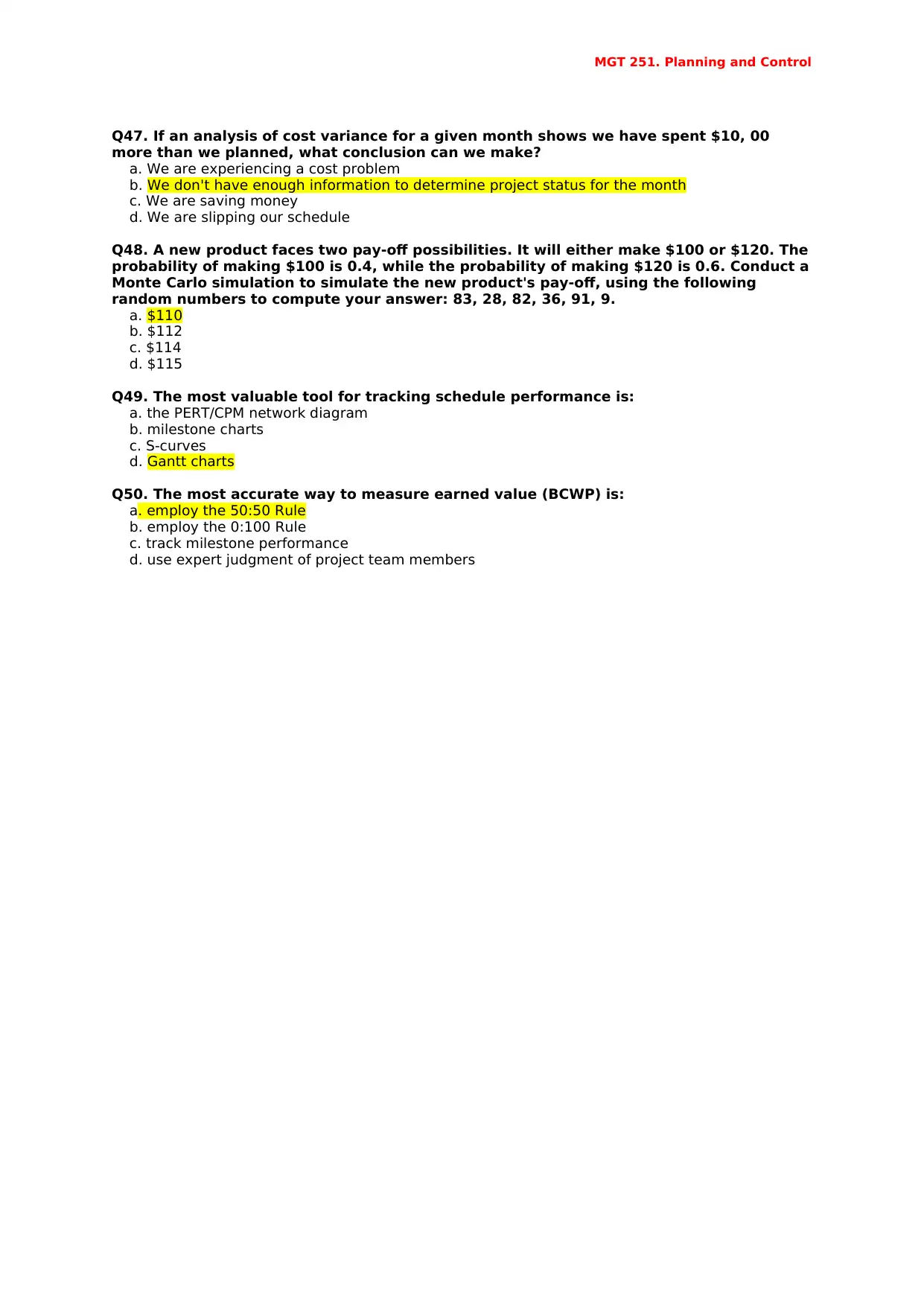
MGT 251. Planning and Control
Q47. If an analysis of cost variance for a given month shows we have spent $10, 00
more than we planned, what conclusion can we make?
a. We are experiencing a cost problem
b. We don't have enough information to determine project status for the month
c. We are saving money
d. We are slipping our schedule
Q48. A new product faces two pay-off possibilities. It will either make $100 or $120. The
probability of making $100 is 0.4, while the probability of making $120 is 0.6. Conduct a
Monte Carlo simulation to simulate the new product's pay-off, using the following
random numbers to compute your answer: 83, 28, 82, 36, 91, 9.
a. $110
b. $112
c. $114
d. $115
Q49. The most valuable tool for tracking schedule performance is:
a. the PERT/CPM network diagram
b. milestone charts
c. S-curves
d. Gantt charts
Q50. The most accurate way to measure earned value (BCWP) is:
a. employ the 50:50 Rule
b. employ the 0:100 Rule
c. track milestone performance
d. use expert judgment of project team members
Q47. If an analysis of cost variance for a given month shows we have spent $10, 00
more than we planned, what conclusion can we make?
a. We are experiencing a cost problem
b. We don't have enough information to determine project status for the month
c. We are saving money
d. We are slipping our schedule
Q48. A new product faces two pay-off possibilities. It will either make $100 or $120. The
probability of making $100 is 0.4, while the probability of making $120 is 0.6. Conduct a
Monte Carlo simulation to simulate the new product's pay-off, using the following
random numbers to compute your answer: 83, 28, 82, 36, 91, 9.
a. $110
b. $112
c. $114
d. $115
Q49. The most valuable tool for tracking schedule performance is:
a. the PERT/CPM network diagram
b. milestone charts
c. S-curves
d. Gantt charts
Q50. The most accurate way to measure earned value (BCWP) is:
a. employ the 50:50 Rule
b. employ the 0:100 Rule
c. track milestone performance
d. use expert judgment of project team members
1 out of 5
Related Documents
Your All-in-One AI-Powered Toolkit for Academic Success.
+13062052269
info@desklib.com
Available 24*7 on WhatsApp / Email
![[object Object]](/_next/static/media/star-bottom.7253800d.svg)
Unlock your academic potential
Copyright © 2020–2025 A2Z Services. All Rights Reserved. Developed and managed by ZUCOL.



